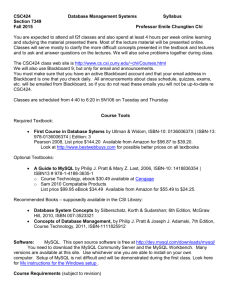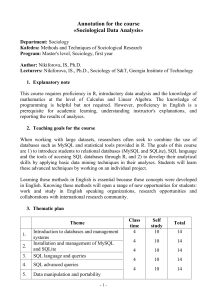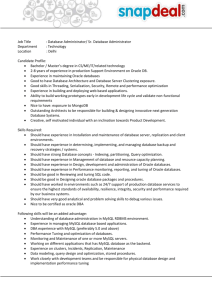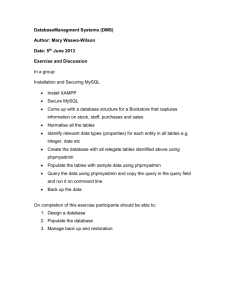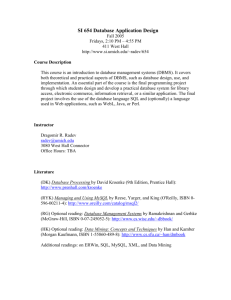Database management system Document Notes
advertisement
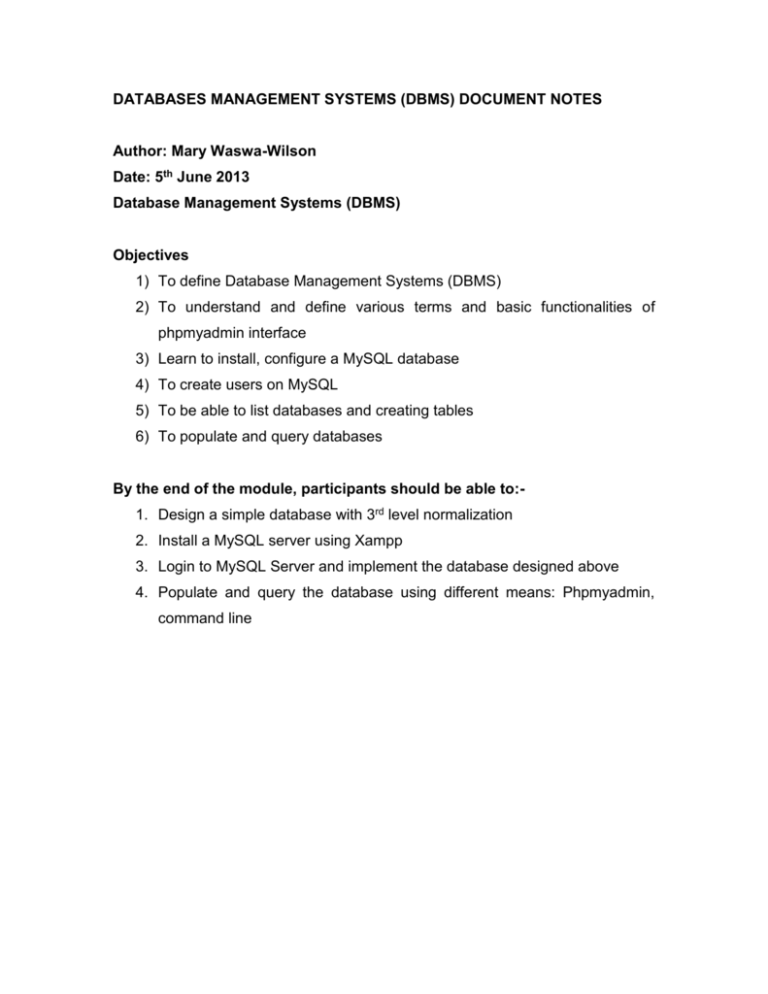
DATABASES MANAGEMENT SYSTEMS (DBMS) DOCUMENT NOTES Author: Mary Waswa-Wilson Date: 5th June 2013 Database Management Systems (DBMS) Objectives 1) To define Database Management Systems (DBMS) 2) To understand and define various terms and basic functionalities of phpmyadmin interface 3) Learn to install, configure a MySQL database 4) To create users on MySQL 5) To be able to list databases and creating tables 6) To populate and query databases By the end of the module, participants should be able to:1. Design a simple database with 3rd level normalization 2. Install a MySQL server using Xampp 3. Login to MySQL Server and implement the database designed above 4. Populate and query the database using different means: Phpmyadmin, command line DATABASE MANAGEMENT SYSTEMS (DBMS) What is a Database? A database is an integrated collection of logically related records or files consolidated into a common pool that provides data for one or more multiple uses. You can think of a database as an electronic filing system. A Database Management System (DBMS) Software that organizes the storage of data. A DBMS controls the creation, maintenance, and use of the database storage structures of organizations and of their end users. In large organizations this task is being manned by a Database Administrator Database management systems are usually categorized according to the database model that they support, such as the network, relational or object model. The model tends to determine the query languages that are available to access the database. One commonly used query language for the relational database is SQL, Database management systems range from all systems that run on personal computers to huge systems that run on mainframes. After storage a DBMS needs an application that can enable us access, modify the information in a contextual manner. Examples of database applications may include: o Computerized library systems - Koha o Automated teller machines (ATM) o Flight reservation systems o Computerized parts inventory systems Database Management System (DBMS) There are several Database Management Systems (DBMS), such as: Microsoft SQL Server Oracle Sybase DBase Microsoft Access MySQL from Sun Microsystems (Oracle) DB2 from IBM etc. The goal of a DBMS is to provide an environment that is both convenient and efficient to use in Retrieving information from the database. Storing information into the database. Databases are usually designed to manage large bodies of information. This involves Definition of structures for information storage (data modeling). Provision of mechanisms for the manipulation of information (file and systems structure, query processing). Providing for the safety of information in the database (crash recovery and security). Concurrency control if the system is shared by users. In our study, this document will focus on MySQL server as our case study DBMS Terminologies: Case Study of MySQL: Before we proceed to explain MySQL database system, let's revise few definitions related to database. Database: A database is a collection of tables, with related data. Table: A table is a matrix with data. A table in a database looks like a simple spreadsheet. Column: One column (data element) contains data of one and the same kind, for example the column postcode. Row: A row (= tuple, entry or record) is a group of related data, for example the data of one subscription. Redundancy: Storing data twice, redundantly to make the system faster. Primary Key: A primary key is unique. A key value cannot occur twice in one table. With a key, you can find at most one row. Foreign Key: A foreign key is the linking pin between two tables. Compound Key: A compound key (composite key) is a key that consists of multiple columns, because one column is not sufficiently unique. Index: An index in a database resembles an index at the back of a book. Referential Integrity: Referential Integrity makes sure that a foreign key value always points to an existing row. MySQL MySQL is a fast, easy-to-use RDBMS being used for many small and big businesses. MySQL is becoming so popular because of many good reasons: MySQL is released under an open-source license. So you have nothing to pay to use it. MySQL is a very powerful program in its own right. It handles a large subset of the functionality of the most expensive and powerful database packages. MySQL uses a standard form of the well-known SQL data language. MySQL works very quickly and works well even with large data sets. MySQL is very friendly to PHP, the most appreciated language for web development. Exercise One: on Practice What makes up a database? Tables The basic units in a database are tables and the relationship between them. Strictly, a relational database is a collection of relations (frequently called tables). Unique key In relational database design, a unique key or primary key is a candidate key to uniquely identify each row in a table. A unique key or primary key comprises a single column or set of columns. No two distinct rows in a table can have the same value (or combination of values) in those columns. A primary key Is a special case of unique keys. The major difference is that for unique keys the implicit NOT NULL constraint is not automatically enforced, while for primary keys it is enforced. Thus, the values in unique key columns may or may not be NULL. Foreign key In the context of relational databases, a foreign key is a referential constraint between two tables. The foreign key identifies a column or a set of columns in one table that refers to a column or set of columns in another table. The columns in the referencing table must be the primary key or other candidate key in the referenced table. The values in one row of the referencing columns must occur in a single row in the referenced table. Thus, a row in the referencing table cannot contain values that don't exist in the referenced table. Views In database theory, a view consists of a stored query accessible as a virtual table composed of the result set of a query. Unlike ordinary tables in a relational database, a view does not form part of the physical schema: it is a dynamic, virtual table computed or collated from data in the database. Changing the data in a table alters the data shown in subsequent invocations of the view Functions In SQL databases, a user-defined function provides a mechanism for extending the functionality of the database server by adding a function that canbe evaluated in SQL statements. Triggers A database trigger is procedural code that is automatically executed in response to certain events on a particular table or view in a database. The trigger is mostly used for keeping the integrity of the information on the database. For example, when a new record (representing a new worker) added to the employees table, new records should be created also in the tables of the taxes, vacations, and salaries. THE PHPMYADMIN COMMAND Working with databases can be a complex and confusing process. Fortunately PhpMyAdmin provides an easy to use and easy to understand interface to administer your database(s). It was intended to handle the administration of MySQL via a web browser. PhpMyAdmin supports a wide range of operations with MySQL. The most frequently used operations are supported by the user interface (managing databases, tables, fields, relations, indexes, users, permissions, etc), while you still have the ability to directly execute SQL statements. Figure 1: phMyadmin interface Understanding Tabs in the Interface Structure: Lists the structor of the databases SQL: Run SQL query/queries on database mysql: Search: Search in database Query: Used to write queries and vuews from table Export: View dump (schema) of database, Export Import: introduce/ import a file Operations: Basic Operations within the database Privileges: Accessing database and user scope to manipulate the database Drop: Used to delete a database or table Database tables Listing and creating database tables At its simplest, a database will consist of tables like this: Name Age Ken Waweru 13 I haven't decided yet. Mike Kibet 37 Red... no, wait ... Arnold Kemboi 82 Favorite Color None of your business. Tables contain records (sometimes called rows), and records contain fields (sometimes called columns) : Field Names: Field 1 Field 2 Field 3 Name Age Favorite Color Record 1 Ken Waweru 13 I haven't decided yet. Record 2 Mike Kibet 37 Red .. no, wait ... Record 3 Arnold Kemboi 82 None of your business. The above is the basic premise of a simple database table, even a real one having millions of records. POPULATING AND QUERYING DATABASES After creating your database, inserting tables, you need to populate it. The LOAD DATA and INSERT statements are useful for this. Suppose that your table was to hold your pet information. Then the records can be described as shown here. name owner species sex birth death Fluffy Harold cat f 1993-02-04 Claws Gwen cat m 1994-03-17 Buffy Harold dog f 1989-05-13 Fang Benny dog m 1990-08-27 Bowser Diane dog m 1979-08-31 1995-07-29 Chirpy f 1998-09-11 Gwen bird Whistler Gwen bird Slim Benny snake 1997-12-09 m 1996-04-29 Because you are beginning with an empty table, an easy way to populate it is to create a text file containing a row for each of your animals. INSERT Statement The INSERT INTO SELECT statement selects data from one table and inserts it into an existing table. Any existing rows in the target table are unaffected. INSERT INTO table2 (column_name(s)) SELECT column_name(s) FROM table1; SELECT Statement The SELECT statement is used to pull information from a table. The general form of the statement is: SELECT what_to_select FROM which_table WHERE conditions_to_satisfy; what_to_select Indicates what you want to see. This can be a list of columns, or * to indicate “all columns.” which_table indicates the table from which you want to retrieve data. The WHERE clause is optional. If it is present, conditions_to_satisfy specifies one or more conditions that rows must satisfy to qualify for retrieval. Back- Ups Introduction It is very important to do backup of your MySql database, you will probably realize it when it is too late. A lot of web applications use MySql for storing the content. This can be blogs, and a lot of other things. When you have all your content as html files on your web server it is very easy to keep them safe from crashes, you just have a copy of them on your own PC and then upload them again after the web server is restored after the crash. All the content in the MySql database must also be backed up. A lot of web service providers say they do backup of all the files, but you should never blindly trust them. If you have spent a lot of time making the content and it is only stored in the Mysql server, you will feel very bad if it gets lost for ever. Backing it up once every month or so makes sure you never loose too much of your work in case of a server crash, and it will make you sleep better at night. It is easy and fast, so there is no reason for not doing it. Backup of Mysql database Open phpMyAdmin. 1. Click Export in the Menu to get to where you can backup you MySql database. 2. Make sure that you have selected to export your entire database, and not just one table. There should be as many tables in the export list as showing under the database name. 3. Select"SQL"-> for output format, Check "Structure" and "Add AUTO_INCREMENT" value. Check "Enclose table and field name with backquotes". Check "DATA", check use "hexadecimal for binary field". Export type set to "INSERT". 4. Check "Save as file", do not change the file name, use compression if you want. Then click "GO" to download the backup file. Restoring a backup of a MySql database 1. To restore a database, you click the SQL tab. 2. On the "SQL"-page , unclick the show query here again. 3. Browse to your backup of the database. 4. Click Go.

